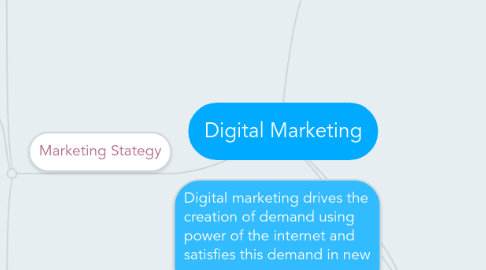
1. Digital marketing drives the creation of demand using power of the internet and satisfies this demand in new ways.
2. Bussines strategy goal: make money
3. Marketing Stategy
3.1. Four pillars
3.1.1. The environment
3.1.1.1. Political
3.1.1.2. Economic
3.1.1.3. Social
3.1.1.4. Technological
3.1.1.5. Legal
3.1.1.6. Environmental
3.1.2. The business
3.1.2.1. Features and attributes
3.1.2.2. Functional benefits
3.1.2.3. Emotional benefits
3.1.2.4. Brand/product persona
3.1.2.5. Brand idea
3.1.3. The customers
3.1.3.1. Customer journey
3.1.4. The competitors
3.2. 1. Building blocks
3.2.1. Porter's five forces analysis
3.2.1.1. 1. Power of suppliers
3.2.1.2. 2. Power of customers
3.2.1.3. 3. Threat of new entrants
3.2.1.4. 4. Threat of substitute products
3.2.1.5. 5. Competetive rivalry within industry
3.2.2. The four Ps
3.2.2.1. 1. Products and services
3.2.2.2. 2. Price
3.2.2.3. 3. Placement
3.2.2.4. 4.Promotion
3.2.2.5. 5. New: People
3.2.3. SWOT analysis
3.2.3.1. Strenght
3.2.3.2. Weaknesses
3.2.3.3. Opportunities
3.2.3.4. Threats
3.3. 2. Crafting marketing strategy
3.3.1. a. Context
3.3.1.1. Examinate the context and stakeholders
3.3.2. b. Value exchange
3.3.2.1. Examinate the value proposition
3.3.3. c. Objectives
3.3.3.1. Objectives: SMART
3.3.3.2. Tactics
3.3.3.3. KPIs: Key performance indicators: pieces of data to determinate if the tactics are performing well and meeting the goals
3.3.3.4. Targets: Specific values set for the KPIs within a specific time period.
3.3.4. d. Tactics and evaluation
3.3.4.1. SEO
3.3.4.1.1. Customer retention and acquisition
3.3.4.2. Search advertising
3.3.4.2.1. Sales, customer retention and acquisition
3.3.4.3. Online advertising
3.3.4.3.1. Branding and acquisition
3.3.4.4. Affiliate marketing
3.3.4.4.1. Sales and branding
3.3.4.5. Video marketing
3.3.4.5.1. Branding, customer retention and value creation
3.3.4.6. Social media
3.3.4.6.1. Branding, value creation and participation
3.3.4.7. e-mail marketing
3.3.4.7.1. Customer retention and value creation
3.3.5. e. Ongoing optimisation
3.3.5.1. Constant change should be considered in the strategy formulation, allowing tactics and strategies be modified as you go.
4. Strategic process
4.1. Think
4.1.1. Research, plan and strategise
4.2. Create
4.2.1. Make Beautiful assets
4.3. Engage
4.3.1. Use channels to drive traffic to those assets and build relationship with customers
4.4. Optimise
4.4.1. Track and analyse how assets and campaigns are performing
